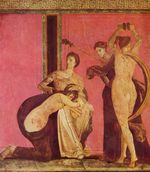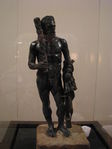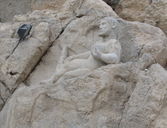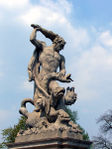Hercules

Gilded bronze "Hercules of the Forum Boarium", with the apple of the Hesperides, Roman 2nd century BCE; found in the Forum Boarium in the 15th century (Capitoline Museums)
|
|||||||
|
Hercules is the Roman name for the Greek demigod Heracles, son of Jupiter (the Roman equivalent of Zeus), and the mortal Alcmena. Early Roman sources suggest that the imported Greek hero supplanted a mythic Italic shepherd called "Recaranus" or "Garanus", famous for his strength, who dedicated the Ara Maxima that became associated with the earliest Roman cult of Hercules.[1] While adopting much of the Greek Heracles' iconography and mythology as his own, Hercules adopted a number of myths and characteristics that were distinctly Roman. With the spread of Roman hegemony, Hercules was worshiped locally from Hispania through Gaul.
Contents |
Etymology
Hercules's Latin name is not directly borrowed from Greek Heracles but is a modification of the Etruscan name Herceler, which derives from the Greek name via syncope, Heracles translates to "The Glory of Hera". An oath invoking Hercules (Hercle! or Mehercle!) was a common interjection in Classical Latin.[2]
Character
In Roman works of art and in Renaissance and post-Renaissance art that adapts Roman iconography, Hercules can be identified by his attributes, the lion skin and the gnarled club (his favorite weapon): in mosaic he is shown tanned bronze, a virile aspect.[3] Hercules was the illegitimate son of Zeus and Alcmene, the wisest and most beautiful of all mortal women. Hera was enraged at Zeus for his infidelity with Alcmene, and even more so that he placed the infant Hercules at Hera's breast as she slept and allowed Hercules to feed, which caused Hercules to be partially immortal, thus, allowing him to surpass all mortal men in strength, size and skill. However, Hera still held a spiteful grudge against Hercules and sent Hercules into a blind frenzy, in which he killed all of his children. When Hercules regained his sanity, he sought out the Oracle at Delphi in the hope of making atonement. The Oracle ordered Hercules to serve Eurystheus, king of Mycenae, who sent him on a series of tasks known as the Labors of Hercules. While he was a champion and a great warrior, he was not above cheating and using any unfair trick to his advantage. However, he was renowned as having "made the world safe for mankind" by destroying many dangerous monsters.
Roman cult

In their popular culture the Romans adopted the Etruscan Hercle, a hero-figure that had already been influenced by Greek culture — especially in the conventions of his representation — but who had experienced an autonomous development. Etruscan Hercle appears in the elaborate illustrative engraved designs on the backs of Etruscan bronze mirrors made during the fourth century BC, which were favoured grave goods. Their specific literary references have been lost, with the loss of all Etruscan literature, but the image of the mature, bearded Hercules suckling at Uni/Juno's breast, engraved on a mirror back from Volterra, is distinctively Etruscan. This Hercle/Hercules — the Hercle of the interjection "Mehercle!" — remained a popular cult figure in the Roman legions.
The literary Greek versions of his exploits were appropriated by literate Romans from the 2nd century BCE onwards, essentially unchanged, but Latin literature of Hercules added anecdotal detail of its own, some of it linking the hero with the geography of the Western Mediterranean. Details of the Greek cult, which mixed chthonic libations and uneaten holocausts with Olympian services, were adapted to specifically Roman requirements as well, as Hercules became the founding figure of Herculaneum and other places, and his cult became entwined with Imperial cult, as shown in surviving frescoes in the Herculanean collegium. His altar has been dated to the 5th or 6th century BC. It stood near the Temple of Hercules Victor. Hercules became popular with merchants, who customarily paid him a tithe of their profits.
Marcus Antonius identified himself with Hercules, and even invented a son of Hercules, called Anton, from whom Antonius claimed descent. In response, his enemy Octavianus identified with Apollo. Some early emperors, such as Trajan, took up the attributes of Hercules, and later Roman Emperors, in particular Commodus and Maximian, went further and often identified or compared themselves with him and supported his cult; Maximianus styled himself "Herculius". The cult of Hercules spread through the Roman world. In their gardens, wealthy Romans would often build altars to Hercules, who was regarded as the benefactor of mankind.[5] In Roman Egypt, what is believed to be the remains of a Temple of Hercules are found in the Bahariya Oasis.
The Romans adopted the myths of Heracles including his twelve labors, essentially unchanged, but added anecdotal detail of their own, some of it linking Hercules with the geography of the Western Mediterranean.
In Roman mythology, Acca Larentia was Hercules' mistress. She was married to Tarutius, a wealthy merchant. When he died, she gave his money to charity. In another version, she was the wife of Faustulus.
In Aeneid 8.195ff, Virgil relates a myth about Hercules' defeating the monstrous Cacus, who lived in a cave under the Palatine Hill (one of the eventual Seven Hills of Rome).
Death of Hercules
Hercules was married to Deianeira. Long after their marriage, one day the centaur Nessus offered to ferry them across a wide river that they had to cross. Nessus set off with Deianeira first, but tried to abduct her. When Hercules realized the centaur's real intention, Hercules chased after him and shot him with a poisoned arrow. Before he died, Nessus told Deianeira to take some of his blood and treasure it: if she ever thought Hercules was being unfaithful, the centaur told her, the blood would restore his love. Deianeira kept the phial of blood. Many years later after that incident she heard rumours that Hercules had fallen in love with another woman. She smeared some of the blood on a robe and sent it to Hercules. When he put on the robe, the blood still poisoned from the same arrow used by Hercules, burnt into his flesh and when he realized this, he told his friends to build him a pyre out of hardy oak and wild olive. He was burnt to death on the pyre; the fire hurt far less than the poison. His father Jupiter then turned him into a god.
Germanic association
Tacitus records a special affinity of the Germanic peoples for Hercules. In chapter 3 of his Germania, Tacitus states:
... they say that Hercules, too, once visited them; and when going into battle, they sang of him first of all heroes. They have also those songs of theirs, by the recital of this barditus[6] as they call it, they rouse their courage, while from the note they augur the result of the approaching conflict. For, as their line shouts, they inspire or feel alarm.
In the Roman era Hercules' Club amulets appear from the 2nd to 3rd century, distributed over the empire (including Roman Britain, c.f. Cool 1986), mostly made of gold, shaped like wooden apples. A specimen found in Köln-Nippes bears the inscription "DEO HER[culi]", confirming the association with Hercules.
In the 5th to 7th centuries, during the Migration Period, the amulet is theorized to have rapidly spread from the Elbe Germanic area across Europe. These Germanic "Donar's Clubs" were made from deer antler, bone or wood, more rarely also from bronze or precious metals. They are found exclusively in female graves, apparently worn either as a belt pendant, or as an ear pendant. The amulet type is replaced by the Viking Age Thor's hammer pendants in the course of the Christianization of Scandinavia from the 8th to 9th century.
In popular culture
Since the Renaissance, Heracles has rarely been distinguished from Hercules, the Roman figure overshadowing the Greek. Later interpretations of Hercules' legend cast him as a wise leader and a good friend (many of the movie and TV adaptations cast him in this light, especially the 1995–1999 syndicated TV series). He was the main character in the Disney animated movie of the same name.
The legend of Hercules endures, though often co-opted to suit the political fashion of the day. Hercules has also had an undeniable influence on modern pop culture characters such as Superman and He-Man. The legend of Hercules has been described in many movie and television adaptations, including several comic series featuring the hero. Hercules has been the hero of both Marvel Comics (where the rendition of Hercules was an early member of the Avengers) and DC Comics adventure comic books. In DC, he has often been associated with Wonder Woman. In Marvel, he currently stars in his own ongoing series titled The Incredible Hercules, where he has dealt with Amadeus Cho, the Hulk, the Eternals, and others.

In numismatics
Hercules has been the main motif of many collector coins and medals, the most recent one is the 20 euro Baroque Silver coin issued in September 11, 2002. The obverse side of the coin shows the Grand Staircase in the town palace of Prince Eugene of Savoy in Vienna, currently the Austrian Ministry of Finance. Gods and demi-gods hold its flights, while Hercules stands at the turn of the stairs.
See also
- Cudgel of Hercules
- Heracles
- Labours of Hercules
- Pillars of Hercules
- Zeus
Gallery
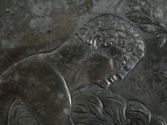 Hercules and the Nemean Lion (detail), silver plate, 6th century (Cabinet des Médailles, Paris) |
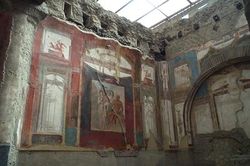 Hercules frescoes in the collegium at Herculaneum |
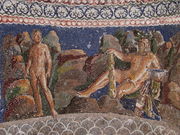 Hercules and his nephew, helper and eromenos Iolaus |
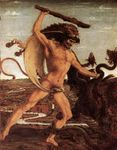 Hercules and the Hydra by Antonio del Pollaiuolo, 15th century |
Comic book cover (c.1958) |
.jpg) The Cudgel of Hercules, a tall limestone rock and Pieskowa Skała Castle in the background |
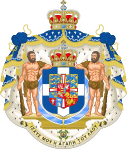 Hercules used as a heraldic supporter in the Coat of arms of the Kingdom of Greece, in use from 1863 to 1973. Greek royalists were sometimes mockingly called "Ηρακλείδες" ("the Herculeses") |
Hercules Filmography (Pepla)
A series of 19 Italian Hercules movies were made in the late 50's/ early 60's. The actors who played Hercules in these films were Steve Reeves, Gordon Scott, Kirk Morris, Mickey Hargitay, Mark Forest, Alan Steel, Dan Vadis, Brad Harris, Reg Park, Peter Lupus (billed as Rock Stevens) and Michael Lane. The films are listed below by their American release titles, and the titles in parentheses are the original Italian titles with English translation.
- Hercules (Le Fatiche di Ercole/ The Labors of Hercules, 1957) starring Steve Reeves
- Hercules Unchained (Ercole e la regina di Lidia/ Hercules and the Queen of Lydia, 1959) starring Steve Reeves
- Goliath and the Dragon (La Vendetta di Ercole/ The Revenge of Hercules, 1960) (this Hercules film had its title changed to Goliath when it was distributed in the U.S.)
- Hercules Vs The Hydra (Gli Amori di Ercole/ The Loves of Hercules, 1960) co-starring Jayne Mansfield
- Hercules and the Captive Women (Ercole alla conquista di Atlantide/Hercules at the Conquest of Atlantis, 1961) (alternate U.S. title: Hercules and the Haunted Women)
- Hercules in the Haunted World (Ercole al centro della terra/Hercules at the Center of the Earth) 1961 (directed by Mario Bava)
- Hercules in the Vale of Woe (Maciste contro Ercole nella valle dei guai/Maciste Vs. Hercules in the Vale of Woe) 1961
- Ulysses Vs. The Son of Hercules (Ulisse contro Ercole/Ulysses Vs. Hercules) 1962
- The Fury of Hercules (La Furia di Ercole/The Fury of Hercules, a.k.a. The Fury of Samson) 1962
- Hercules, Samson and Ulysses (Ercole sfida Sansone/Hercules Challenges Samson) 1963
- Hercules Vs. the Moloch (Ercole contro Molock/Hercules Vs. Moloch, 1963) (alternate U.S. title: The Conquest of Mycene)
- Son of Hercules in the Land of Darkness (Ercole l'invincibile/Hercules, the Invincible) 1964 (this was originally a Hercules film that was retitled to "Son of Hercules" so that it could be included in the "Sons of Hercules" TV syndication package)
- Hercules Vs. The Giant Warrior (il Trionfo di Ercole/The Triumph of Hercules, 1964) (alternate U.S. title: Hercules and the Ten Avengers)
- Hercules Against Rome (Ercole contro Roma, 1964)
- Hercules Against the Sons of the Sun (Ercole contro i figli del sole, 1964)
- Hercules and the Tyrants of Babylon (Ercole contro i tiranni di Babilonia, 1964)
- Samson and the Mighty Challenge (Ercole, Sansone, Maciste e Ursus: gli invincibili, 1964) (a.k.a. Combate dei Gigantes)
- Hercules and the Princess of Troy (a.k.a. Hercules vs. the Sea Monster) No Italian title, 1965 (this 48-minute Italian/U.S. co-production was made as a pilot for a Charles Band-produced TV series that never materialized)
- Hercules, the Avenger (Sfida dei giganti/Challenge of the Giants, 1965) This film was comprised mostly of stock footage from 2 earlier Reg Park Hercules films, made to be released directly to U.S. television
The Three Stooges made an American comedy in 1962 called The Three Stooges Meet Hercules with Samson Burke playing Hercules. Note* - A number of English-dubbed Italian films that featured the Hercules name in their title were never intended to be Hercules movies by their Italian creators.
- Hercules, Prisoner of Evil was actually a retitled Ursus film.
- Hercules and the Black Pirate and Hercules and the Treasure of the Incas were both retitled Samson movies.
- Hercules and the Masked Rider was actually a retitled Goliath movie.
- Hercules Against the Moon Men, Hercules Against the Barbarians, Hercules Against the Mongols and Hercules of the Desert were all originally Maciste films.
None of these films in their original Italian versions were connected to the Hercules character in any way. Likewise, most of the Sons of Hercules movies shown on American TV in the 1960s had nothing to do with Hercules in their original Italian incarnations.
References
- Notes
- ↑ Servius, commentary on the Aeneid viii. 203, 275 ; Macrobius, Saturnalia iii. 12.
- ↑ W. M. Lindsay, "Mehercle and Herc(v)lvs. [Mehercle and Herc(u)lus]" The Classical Quarterly 12.2 (April 1918:58).
- ↑ Hercules almost suggests "Hero". The Classical and Hellenistic convention in frescoes and mosaics, adopted by the Romans, is to show women as pale-skinned and men as tanned dark from their outdoor arena of action and exercising in the gymnasium.(See also Reed.edu, jpg file. Reed.edu, subject).
- ↑ The sculpture had been carefully buried in Antiquity, having been struck by lightning.
- ↑ Martial, book VII .
- ↑ or, baritus, there being scribal variants. In the 17th century, the word entered the German language as barditus and was associated with the Celtic bards.
- Sources
- Charlotte Coffin. "Hercules" in Peyré, Yves (ed.) A Dictionary of Shakespeare's Classical Mythology (2009)
External links
- Sword and Sandal#Hercules series (1957–1965) The Italian "Hercules" Filmography
- Etruscan mirror illustrated Uni and Hercle
- Hercle and Menerva on an Etruscan mirror from Città di Castello, c 300 B.C.: Badisches Landesmuseum
- Images of Hercules
|
|||||
